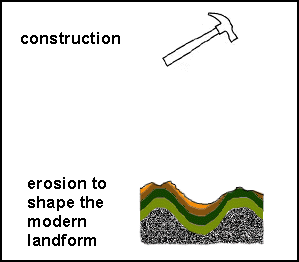The term "origin" may have several different meanings. For example, when we talk about the 'origin' of a house, we may be referring to: - the wish to build
- the architectural plan.
- the source of financing.
- the method of construction.
- all of these.
|
 |
Similarly, when talking about the origin of a landform, we may be referring to:- the mechanism by which its shape was created (e.g., carved by running water; built up by the deposition of sediment; squeezed up by deforming forces).
|  |
- Or else we may referring to a historical sequence of events that led to its formation (e.g., erosion of a preexisting landform to create loose sediment; transport and then deposition of that sediment to form a series of layers; transformation of those sediment layers to form layers of rock; the generation of forces within the earth that deform the rock layers; and finally, erosion of the deformed rock layers to create the shape that we see today).
|
 |
For the purposes of this course, we shall assign the simplest meaning to the phrase "origin of a landform": the last step in the historical sequence of events that led to the creation of the landform. That is, the mechanism by which its current shape was created. - For the 'origin of a house' example, that would mean construction
- For the landform example, that would mean the mechanism by which the surrent shape wasd achieved (in the sequence shown, the mechanism would be erosion).
|
 |
 From your own experience, describe an example illustrating both the 'historical' meaning of 'origin' and the meaning of origin as used in this course. From your own experience, describe an example illustrating both the 'historical' meaning of 'origin' and the meaning of origin as used in this course.
|




 From your own experience, describe an example illustrating both the 'historical' meaning of 'origin' and the meaning of origin as used in this course.
From your own experience, describe an example illustrating both the 'historical' meaning of 'origin' and the meaning of origin as used in this course.